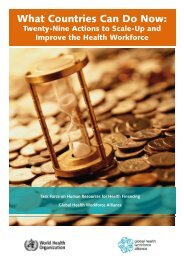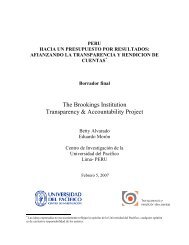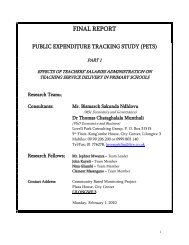Provider Purchasing and Contracting for Health Services_The Case
Provider Purchasing and Contracting for Health Services_The Case
Provider Purchasing and Contracting for Health Services_The Case
Create successful ePaper yourself
Turn your PDF publications into a flip-book with our unique Google optimized e-Paper software.
managers observed that most of the private facilities provide primary <strong>and</strong> first-level care<br />
which is well covered in government <strong>and</strong> mission facilities. In some rural districts, such as<br />
Choma <strong>and</strong> Mazabuka, the managers observed that the private <strong>for</strong>-profit facilities were<br />
nonexistent, <strong>and</strong> contracting-out was there<strong>for</strong>e limited.<br />
Furthermore, one of the respondents observed that investing in government <strong>and</strong> mission<br />
hospitals instead of contracting with the extremely expensive private <strong>for</strong>-profit providers<br />
could be more cost-effective.<br />
Some contractees (in the private <strong>for</strong>-profit sector) complained that District <strong>Health</strong><br />
Management Teams <strong>and</strong> public hospitals do not often honor their payments in full <strong>and</strong><br />
suggested that compliance mechanisms need to be put in place. Moreover, some respondents<br />
observed that increased interaction with the government through contracting could merely<br />
increase government regulations <strong>and</strong> stifle the development of the private sector.<br />
Potential model <strong>for</strong> private sector contracting<br />
Despite the above constraints, almost all managers agreed that contracting-out could give<br />
patients the right to choose their preferred provider <strong>and</strong> decongest the overcrowded public<br />
hospitals. In this regard, respondents observed that the health board model offered more<br />
flexibility to managers that could be exploited to enter into strategic contracting with the<br />
private <strong>for</strong>-profit providers. <strong>The</strong>y emphasized the need <strong>for</strong> autonomy at the provider level <strong>for</strong><br />
effective <strong>and</strong> efficient decision making. <strong>The</strong> merging of providers into the public service<br />
mainstream has introduced bureaucracies that could militate against effective contracting-out.<br />
Some managers argued that if providers are sufficiently funded <strong>and</strong> are given autonomy,<br />
contracting-out to private <strong>for</strong>-profit providers can still be successful under the current<br />
arrangements.<br />
However, policymakers observed that the government, through the Ministry of <strong>Health</strong>, is<br />
developing a social health insurance scheme that presents a huge opportunity <strong>for</strong> contractingout<br />
if well funded. Accordingly, institutions in both the public <strong>and</strong> private sectors will have to<br />
be accredited to qualify as providers under this scheme.<br />
Per<strong>for</strong>mance assessments<br />
As action plans are implemented, contractors follow up to assess the extent to which<br />
providers are abiding by the contractual agreements. <strong>The</strong> contracts provide <strong>for</strong> the following:<br />
Quarterly Per<strong>for</strong>mance Audits. <strong>The</strong>se service <strong>and</strong> quality control audits were <strong>and</strong> are<br />
intended to measure or assess the extent to which minimum st<strong>and</strong>ards in the provision of<br />
health care are maintained. <strong>The</strong>y assess all aspects of service delivery, both in terms of<br />
clinical <strong>and</strong> nonclinical functions. <strong>The</strong>se include the diagnosis, equipment, financial, <strong>and</strong><br />
human resource factors as inputs into the process of service delivery. While the Central<br />
Board of <strong>Health</strong> system adhered to this provision, the Ministry of <strong>Health</strong> is not consistent<br />
with per<strong>for</strong>mance audits. All managers described the current audits as being very erratic <strong>and</strong><br />
inconsistent, taking place only once or twice a year.<br />
Quarterly Financial, Administrative, <strong>and</strong> Management Reports <strong>and</strong> Status. Financial<br />
per<strong>for</strong>mance as a basic input into the provision of health care is supposed to be assessed<br />
quarterly so as to gauge aspects relating to transparency, effectiveness, <strong>and</strong> efficacy of<br />
53
















